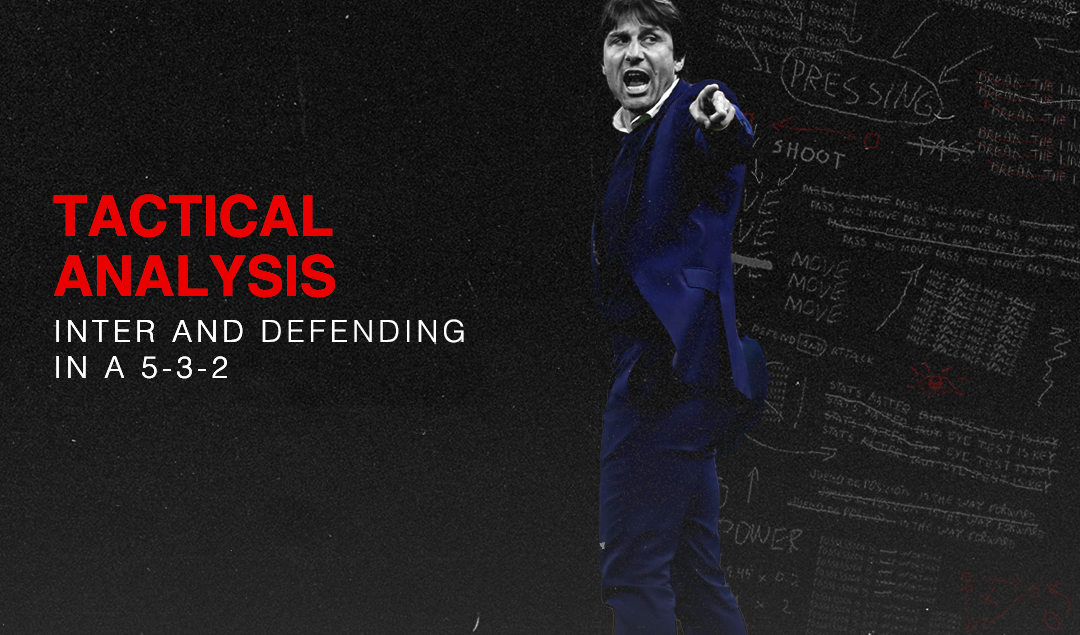Tactical Analysis: Inter Milan and Defending in a 5-3-2
This article will investigate the 5-3-2 more abstractly, and subsequently use Antonio Conte’s Inter as a case study of the shape. Inter are the highest quality team currently operating with the shape and therefore can highlight its advantages to the greatest extent and reveal why playing in such a way is viable for runaway champions; showing that defensive proactivity is not a requisite for success.
However, there has also been a positive correlation between their passivity and defensive record as they switched from the higher pressing 3-4-1-2 shape which often left their centre backs isolated in man-oriented duels to the 5-3-2 which suggests the alteration has been effective in strengthening the team as a defensive unit. Games that highlighted the defensive vulnerability of the previous shape, despite its good attacking output include the season opener against Fiorentina which ended 4-3, most notable for the stellar performance of Franck Ribéry and the 3-2 against Real Madrid.
There were personnel caveats such as Aleksandar Kolarov and Danilo D’Ambrosio playing more frequently, in addition to offensive gains through greater sustenance of pressure. Nevertheless, the significance of the change in results and goals conceded indicates factors above personnel were paramount and the offensive trade-offs were worthwhile. The fundamental problem a defensive shape must answer is that of the compactness/coverage conundrum.
This conceptualisation considers a trade-off between how compact a team can be, which is useful because it limits the playing space of the opposition thus increasing the chances of a turnover occurring as more players have good proximity to the ball carrier and potential recipients. Hypothetically, when pressing, space becomes increasingly constrained making exposing the compactness difficult as the ball carrier becomes increasingly isolated due to pressure which limits the time and space he has.
Compactness therefore has a deterrent effect that allows it to act as a funnel. However, should the space restriction not be successful, and the opponent manages to find sufficient time and space in possession, compactness can be exposed as more technically difficult tasks can be accomplished unpressured, leading to the important aspect of coverage.
This refers to what areas of the pitch are covered, and the extent to which they are – for instance, the ball-side typically has better coverage as the team looks to remain compact out of possession and use the ball as a reference point for positioning, leading to an underloaded and potentially uncovered far-side. Should a full back lurk, that would be considered poor coverage rather than absent coverage.
Hence, the more nominal coverage, the worse compactness as more ground is covered and hence each player is responsible for a greater deal, increasing the space in between the lines. Accordingly, the better the compactness the worst the coverage as players need to cover less space, reducing the space in between the lines; however, increasing the space uncovered by the team out of possession.
Teams must limit effective space to balance this conundrum, attempting to lower the amount of space that is directly playable by the opposition to remain compact while covering all relevant zones. The 5-3-2 seeks to achieve this by prioritising engagements that occur on the flanks and on the second line where their numerical overloads are most likely to be seen.
This is because the shape is centrally compact and thus naturally funnels play down the flanks. The ball side wing-back is often responsible for stepping out, creating an asymmetric 4-4-2 shape, as the ball side centre back covers the effective space in behind i.e., following the runner into space.
Man orientation from centre backs is common to plug gaps in between the lines, seeking to get tight to make ball reception difficult, thus preventing exposure of the last line should the opponent’s interior player receive. Backwards reception has a compacting effect because, when the opposition marker is tight, progressive options are closed off, limiting whatever space is in front, reducing potential options.
Shuttling is a crucial aspect when the ball is moved to the flanks to maintain compactness and allow the ball side midfielders to get tight to their respective men to help constrain the pitch and produce a turnover. The centre forwards often look to show their respective centre back to wide area’s by pressing in a manner that cuts the lateral passing lane whilst the other forward can drop onto the opponent’s defensive midfielder, although particularly in deeper regions, because of the lack of forward coverage, passivity can be seen if the centre backs are perceived as unable to threaten with direct balls in behind.
This passivity can be explained by a desire to remain vertically compact, thus sacrificing coverage to make reception for midfielders and progression by defenders more difficult. Alternatively, better far-side coverage could be prioritised over midfield coverage with the central midfielder stepping out and taking responsibility for central defensive midfielder, granting the far side centre forward more freedom to remain wider – opting for more of a man rather than zonal orientation.
However, it is rare that the defensive midfielder will be followed should they create a back 3, with the responsibility being passed to the forwards or support from one of the wide midfielders occurring in a higher pressing system. The wide midfielders moreover frequently use the man as a reference point for positioning as preventing central progression is paramount to the pressing strategy, particularly in the more common mid-to-low block variants.
In essence, in most manifestations, blocking crucial space and engaging in potentially constraining areas is prioritised over high frontal coverage and pressing where the centre backs would frequently be required to engage in man-oriented duels in favour of a more passive approach.
Man-orientation is used in a non-dangerous manner predominantly because there is sufficient cover resultant from the lack of forward ambition in the press. This allows for the positive effect of difficult ball reception, while negating the negative effect of space exposure, for the price of ceded territory through a lower line of engagement, particularly for the midfield line, as levels of forward harrying is generally more variable.
This leads to 5-3-2 teams preferring to defend in mid-to-low block type situations, where territory is gradually ceded to a patient opponent as they seek to protect crucial central and deep spaces through maintaining horizontal and vertical compactness which often leads to dropping off. The back 5 provides the defence with coverage of the traditional vertical zones in positional play allowing from an element of zonal man-coverage to deal with defensive rotations whereby players are passed on zonally rather than rigidly followed.
As such, this allows the team in the 5-3-2 to better deal with potential overlaps occurring because the inverting winger can be tracked by the ball-side centre back and the overlapping run the wingback. This negates the wide threat, while simultaneously encouraging it through the central compactness.
The defensive coverage on the last line moreover provides protection against potential switches of play, although if executed quickly, the wingback can still be isolated in potential 2v1 situations, particularly if coming narrow to support compactness and ball-sided coverage prior with their far-side wingback and centre back having to go wide when pressing.
Inter
When facing a single pivot, the forwards typically orient themselves around the defensive midfielder when possession is central, compacting the space around him as to deter direct central progression. This additionally gives them a launching point to more ball-sided pressure. After applying pressure to the centre back, forcing a pass, the priority alters as the forward who applied pressure subsequently drops to follow the defensive midfielder, leaving the backwards pass open.
The pressure however is not always applied due to Inter’s lower line of engagement (typically around the centre circle) once possession has been consolidated, meaning the ball-side forward will often track the defensive midfielder coming short directly while the ball-sided midfielder is deemed responsible for the deep half-space occupier, such as that of a narrow full back, tucked in defensive midfielder in a double pivot or wide centre back.
Whilst the wing back is oriented around the opponents’ wide threat, meaning they may jump higher to engage should the opponents primary width be deep, but not so deep as to be lateral with the centre backs. The centre backs are responsible for tracking movements which occur in between the lines during this mid-block phase.
In addition, it should be noted Inter most frequently face single pivot like situations because their defending encourages subtracting a man from the midfield line to either drop into a three to provide the numerical superiority against the forward two and free the centre backs.
For example, Sassuolo who typically play a 4-2-3-1, frequently dropped midfielder Maxime Lopez into the defence to allow the ball-side full back to push higher, subsequently allowing the ball-side winger to come into the half-space. A 3-1 shape is typically viewed as optimal against a front pressing two because of the horizontal stretching of the wide centre backs in addition to the security provided by the numerical superiority.
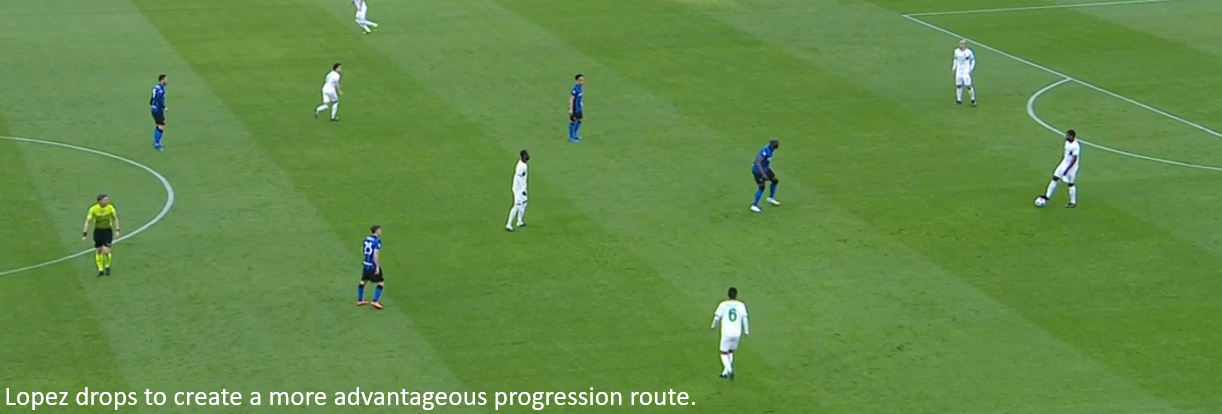
To illustrate the base principles of engagement against a team in the first phase of consolidated possession, consider this sequence against Napoli. Firstly, Kalidou Koulibaly is unpressured by Romelu Lukaku as he has not yet reached Inter’s line of engagement. He moves possession to full back Mário Rui, holding width, who gets pounced upon by Achraf Hakimi who has the responsibility of preventing progression down the flanks and thus looks to get tight as to compact the pitch and limit Rui’s passing options.
Milan Škriniar follows Lorenzo Insigne under similar rationale, but with the additional point of closing down effective space in between the lines, compensating for the ball-sided midfielder being more man-oriented when centre back has possession. This highlights the concept of effective space well because it works under the idea that it is beneficial to temporarily vacate space, presuming there is no viable way to access it, and when there is, sufficient time to restructure would have elapsed.
Thus, theoretically transitioning from deterring access to the space, to limiting the options within the space because the compactness grants more opportune pressing opportunities. Because of the numerical superiority granted through ignoring Koulibaly, Nicolò Barella can play a more proactive role, cutting the pass to Fabián Ruiz rather than marking reception as Lukaku has deeper space covered.
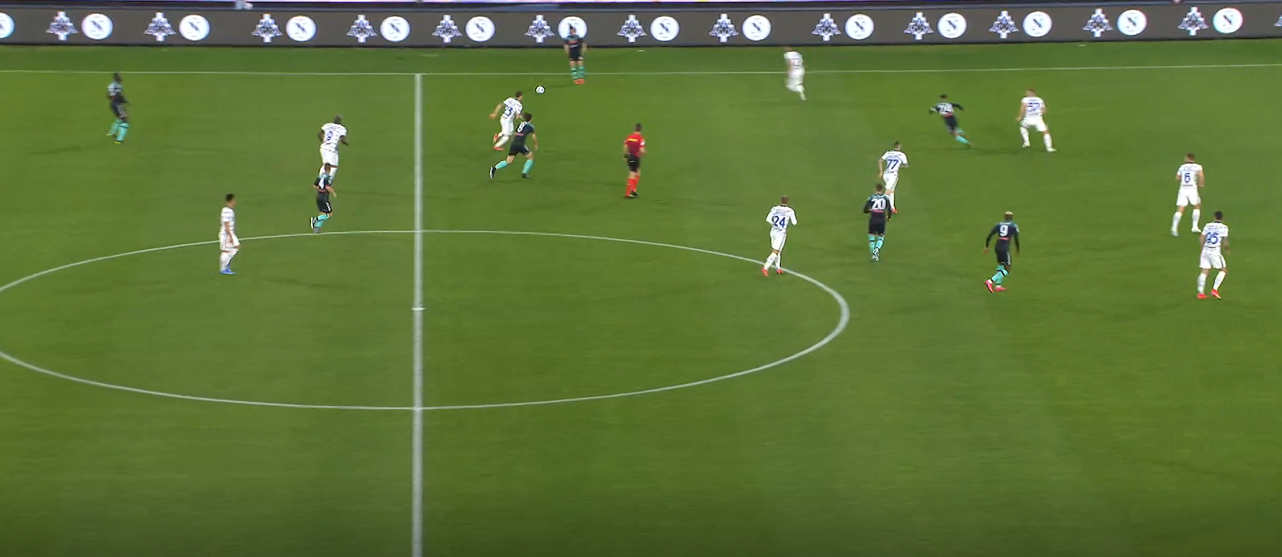
This example can be considered a pressing tap rejected, as Inter looked to compact the space through tight marking once Napoli’s players once they entered their zone of engagement where they had sufficient compactness to effectively compress due to the lower line of engagement.
This reduced the area of effective space should Napoli have attempted short interplay at the cost of nominal coverage for Inter. Thus, the trigger of the pass to the full back was required for Inter to engage with intensity, and following the backwards pass to Koulibaly, they dropped the intensity and restructured.
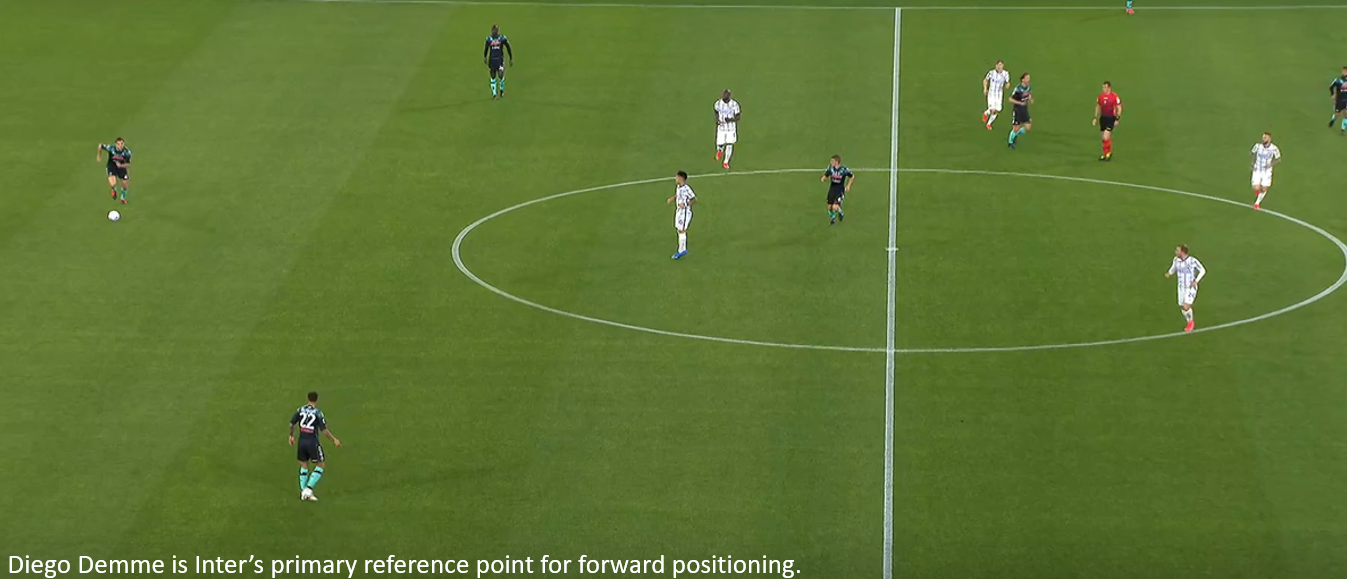
Subsequently, the ball moved centrally as Napoli sought to change the ball-side attempting to expose potential lack of coverage and force Inter’s midfield to shuttle. Diego Demme as Napoli’s single pivot acts as the crucial reference point for positioning when the ball is central for the forward player. However, when the play is cycled to the deep half-space occupier, Christian Eriksen is responsible for closing him down.
Why was Eriksen focusing on right back Giovanni Di Lorenzo when Hakimi was responsible for Rui? The short answer is that zonal requirements supersede that of nominal positional requirements for Inter, taking the perspective that when a category loses its utility, it should be abandoned rather than treated with abstract objectivity, hence the rather peculiar title of deep half-space occupier as it is more precise.
The wing back stays wider whereas the wide midfielder stays in the half-space to maintain good midfield spacing – think back to the point of the emphasis being to block space rather than quickly generate a turnover. Horizontal tracking leads to structural disorganisation whereas vertical tracking, as mentioned has a compacting effect which can compensate through the reduction of effective space theoretically. To cover for a potential midfield deficit caused by Eriksen jumping out to pressure, Lautaro Martínez as the ball-side forward continues to follow Demme.
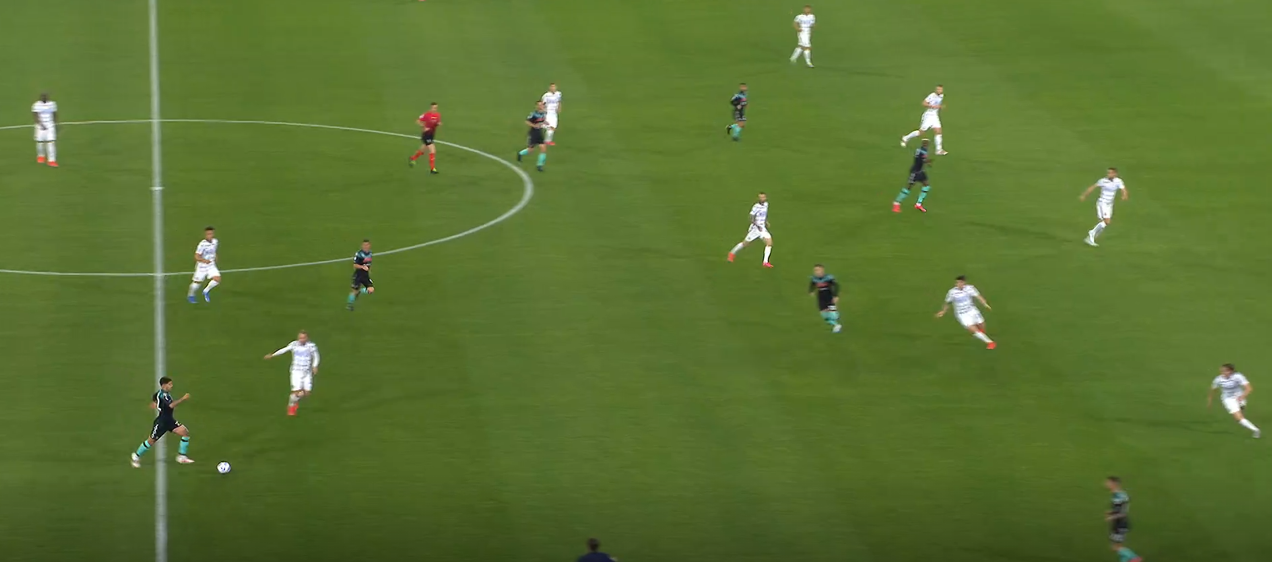
The central space requires covering if the pressure is ineffective, so, the ball-side forward will drop deeper onto the higher central player. This allows the progressive passing option to be marked by the ball-sided midfielder, pressuring the ball carrier into a backwards pass which allows Inter to regain the structure and move to their mid-block.
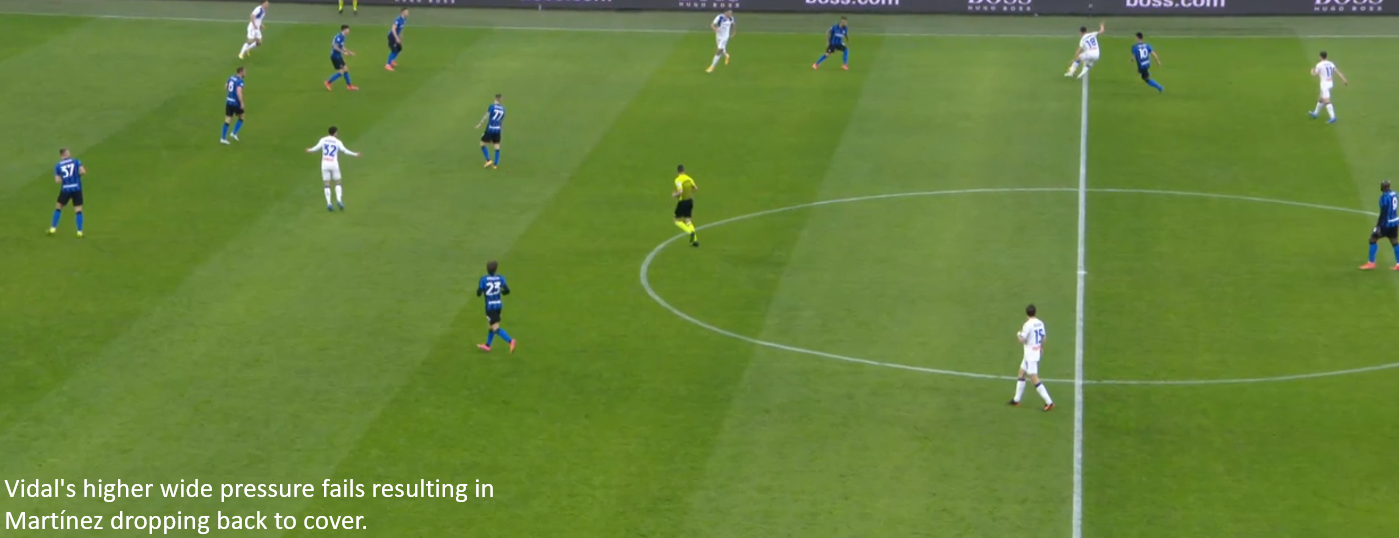
To reiterate the importance of zonal rather than nominal requirements with regards to tight marking observe Alessandro Bastoni tracking Piotr Zieliński because he is the half-space player in between the lines, like nominal winger Insigne was on the opposite flank. Accordingly, nominal winger Matteo Politano holding width makes him the responsibility of Matteo Darmian.
Depending on opposition positioning, the pressing shape on the ball-side can either look like an asymmetric 4-4-2 or 3-5-2 (tucked in wingback on the far side) with a high stepped out ball-side wingback in response to the wider, higher positioning of a full back and/or an aggressive pressing centre back in response to dropping or a 5-2-3 where the width holder is so high as to pin the wingback in addition to having a deep half-space occupier.
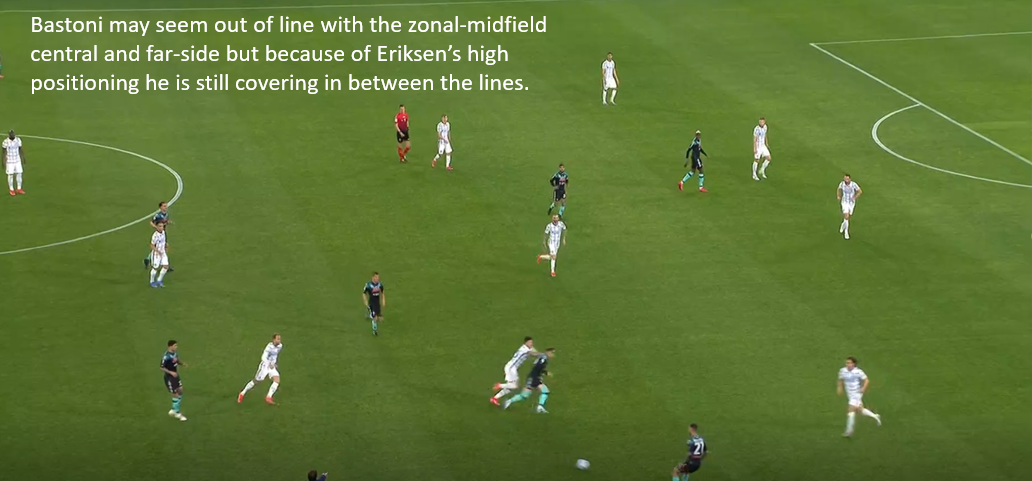
The 5-2-3 shape was commonly seen against Sassuolo who use two deep half-space occupiers when building up in contrast to Napoli’s one. This resulted in the free man in the dropping double pivot (far-side) player being free as Roberto Gagliardini, the wide midfielder needs to orient himself around the deeper threat of Hamed Junior Traorè during deep possession because it is too early for Matteo Darmian, occupying the wide centre back role to step out and cover the space in between the lines that would arise upon Gagliardini’s pressure. When possession is circulated to Lopez, more intense pressure can begin on his side, pushing Gagliardini wider, and Darmian forward in a man-oriented fashion.
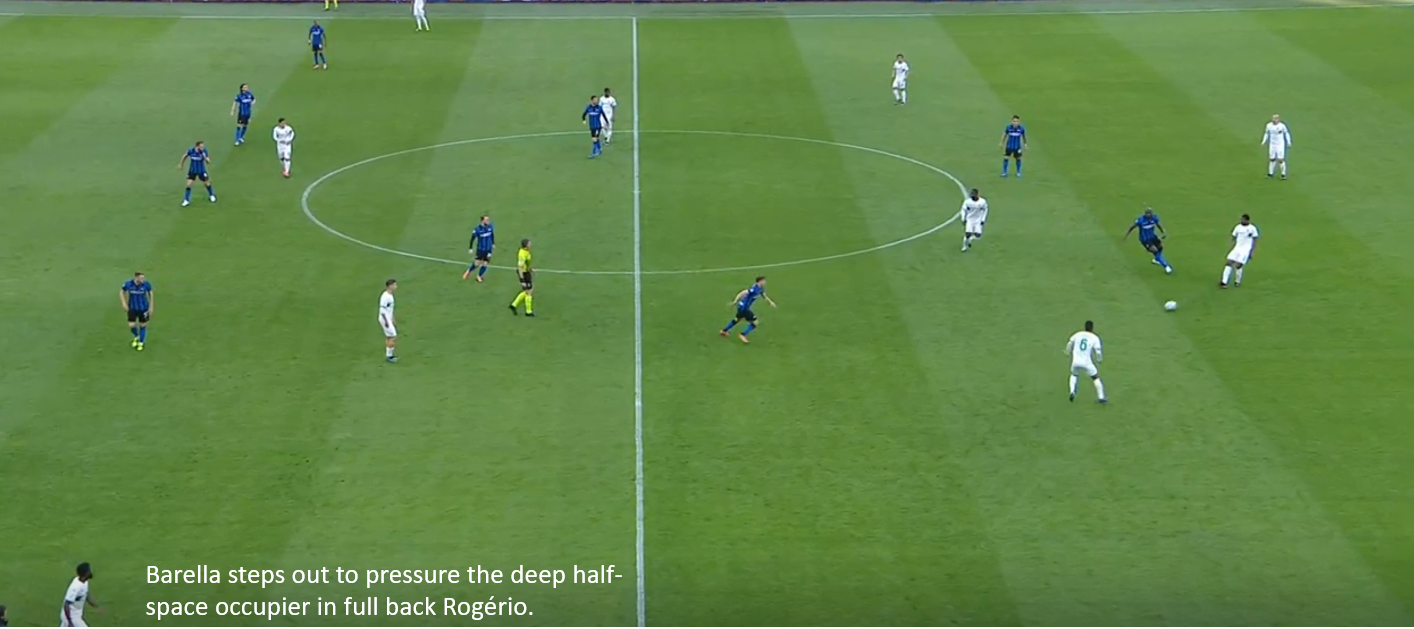
The functioning of their back 5, not being oriented around players but rather roles occupied by players within particular zones effectively combated Sassuolo’s maximum width holding because the wingbacks could continually stay on dangermen Jérémie Boga and Domenico Berardi contrasted to the higher pressing more man-oriented approach of say, Atalanta, showing a good response to the coverage/compactness conundrum as they were able to respond to Sassuolo’s central compactness and full pitch coverage ably through allowing deeper ball possession and protecting central spaces while simultaneously preventing the wingers from functioning as outlets.
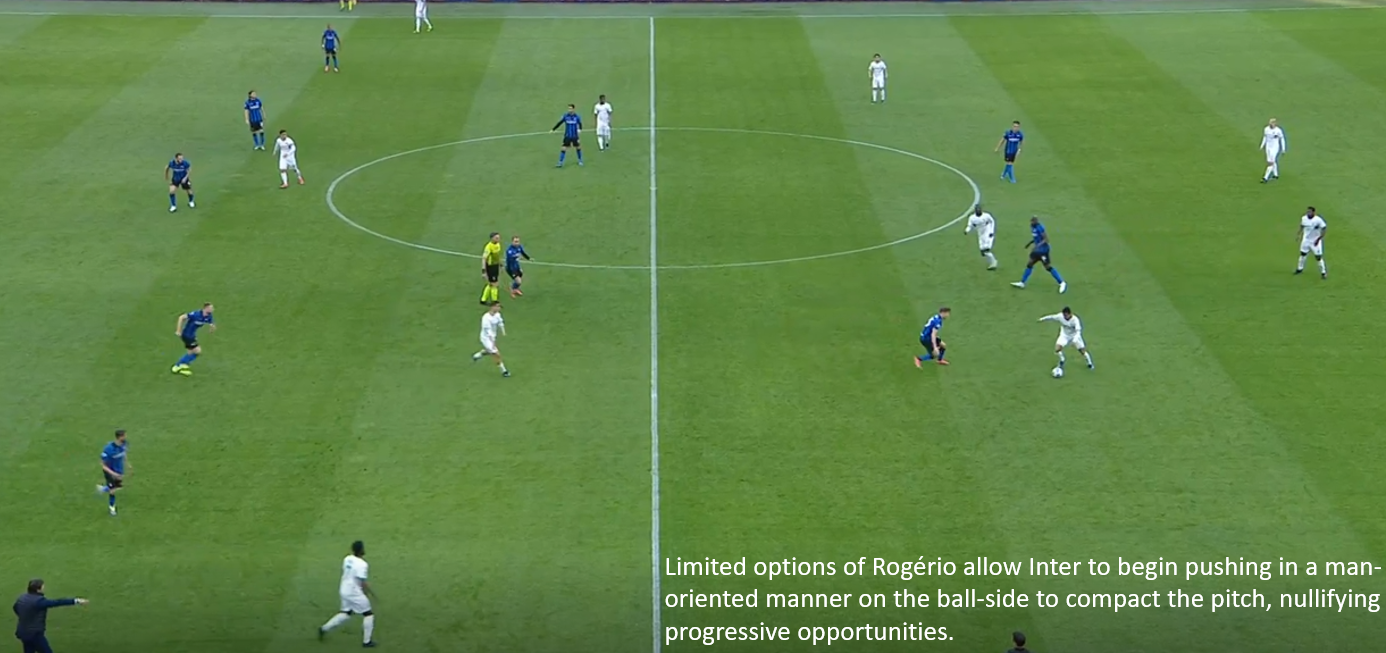
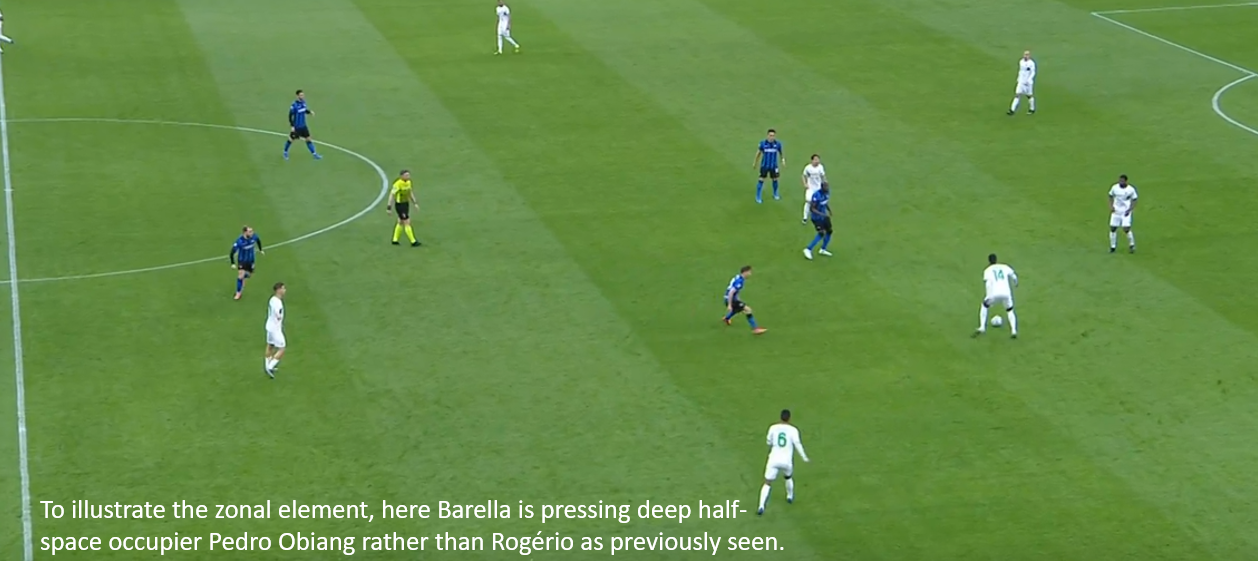
This approach allowed Inter to achieve numerical parity on Sassuolo’s second line, permitting guidance of the ball into particular areas, a pistoning effect, where numerically advantageous situations would appear again and limit the ability for Sassuolo to infiltrate in between the lines or successfully isolate winger with wing back. Should Sassuolo consolidate, the ball-side wide midfielder re-groups as the team drop deeper to form a 5-3-2 shape.
Therefore, from the opponents’ deep consolidated possession Inter can be considered to have a zonal-man orientation whereby players can be passed depending on the zone they occupy; however, getting tight is an important mechanism to prevent progression through making ball reception difficult and preventing turning for more progressive options to expose the compactness generated by the aggressive marking.
In central areas, the central options are prioritised, with the wingbacks typically holding distance on the wider players (assuming they are more traditional full backs and deeper) until triggered by a pass. This has the positive effect of compacting the pitch when the opponent attempt to progress by limiting the effective space in behind, while is relatively safe because of their reluctance to press high generates numerical superiorities defensively which provide sufficient cover for lost duels and can help when pressing becomes ball-oriented for a recovery following a pressing trap.
Through having the wingback deeper initially it permits more CB aggression through the potential to cover and shuttle (or as will be shown, the wing-back to take that responsibility rotating horizontally with the centre back to an extent), maintaining good last line coverage in contrast to initial aggressive positioning, which while making the full back option less attractive, would create more space in between the lines to be covered by the centre backs, and reduce their cover for a lost duel.
Inter’s pressing traps are often to deter opponents from progressing centrally, and to prevent Inter from being exposed to transitional moments from chasing the ball too far and being vertically stretched accordingly. This numerical commitment invites the opponent forward to break Inter down, providing potential transitional moments due to poor opposition coverage if a turnover does occur. This set-up prior to the broken first line can be considered Inter’s high-to-mid block.
To summarise, the primary purpose of the first line engagement is to show the ball into areas where pressing traps can be created through man-orienting on the ball-side. Frontal coverage is sacrificed from the compactness necessary to achieve these traps while simultaneously having enough players back in reserve to cover for potential bypassing. The front players funnel and the ball-sided players engage in a man-pressing fashion to prevent progression.
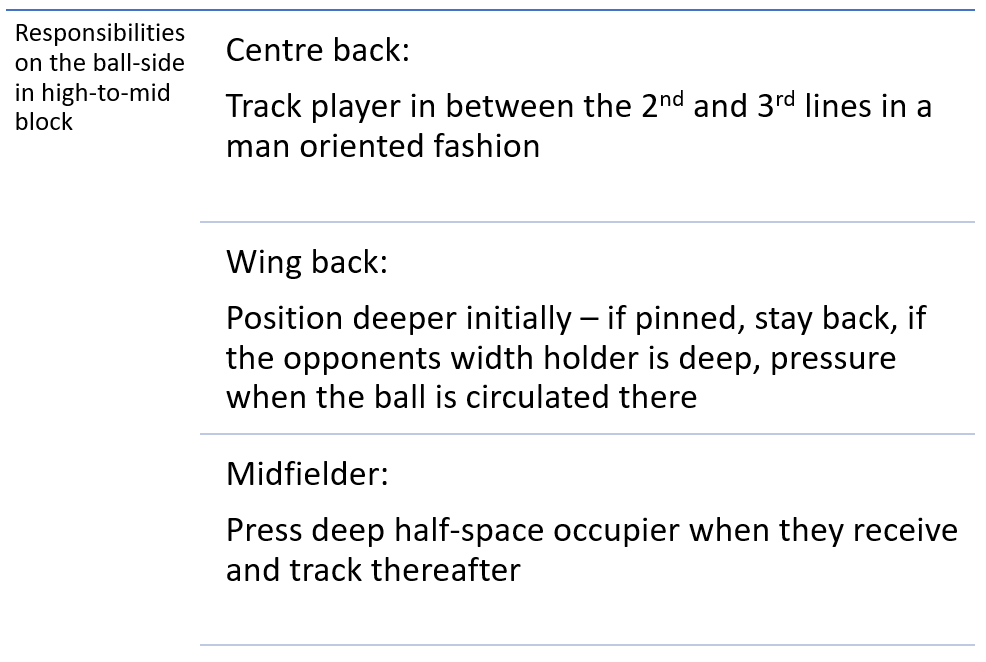
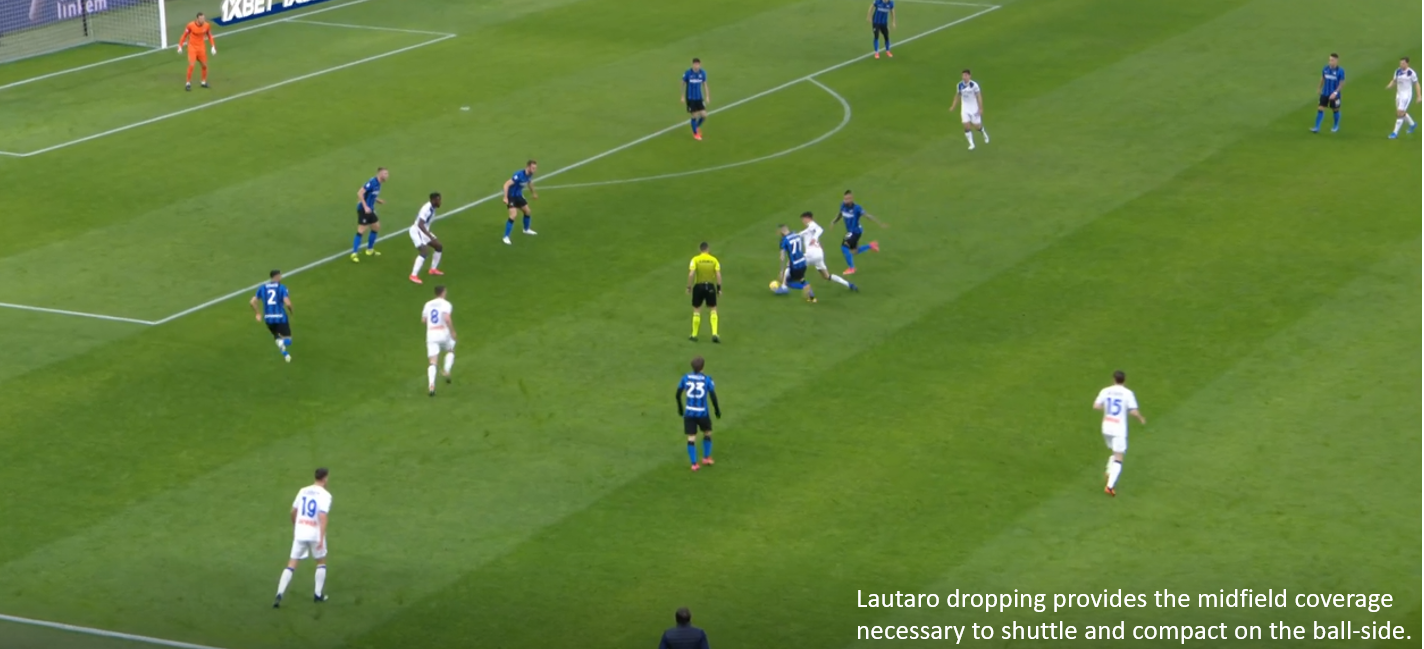
When engaging in higher regions of the pitch, for instance from goal kicks, where vertical stretching can occur with greater ease, the centre backs are more reticent to step out because of the reduced protection of the compactness preventing space exposure. The centre backs can be considered to be requiring the compactness of the mid-block to effectively step out and limit effective space.
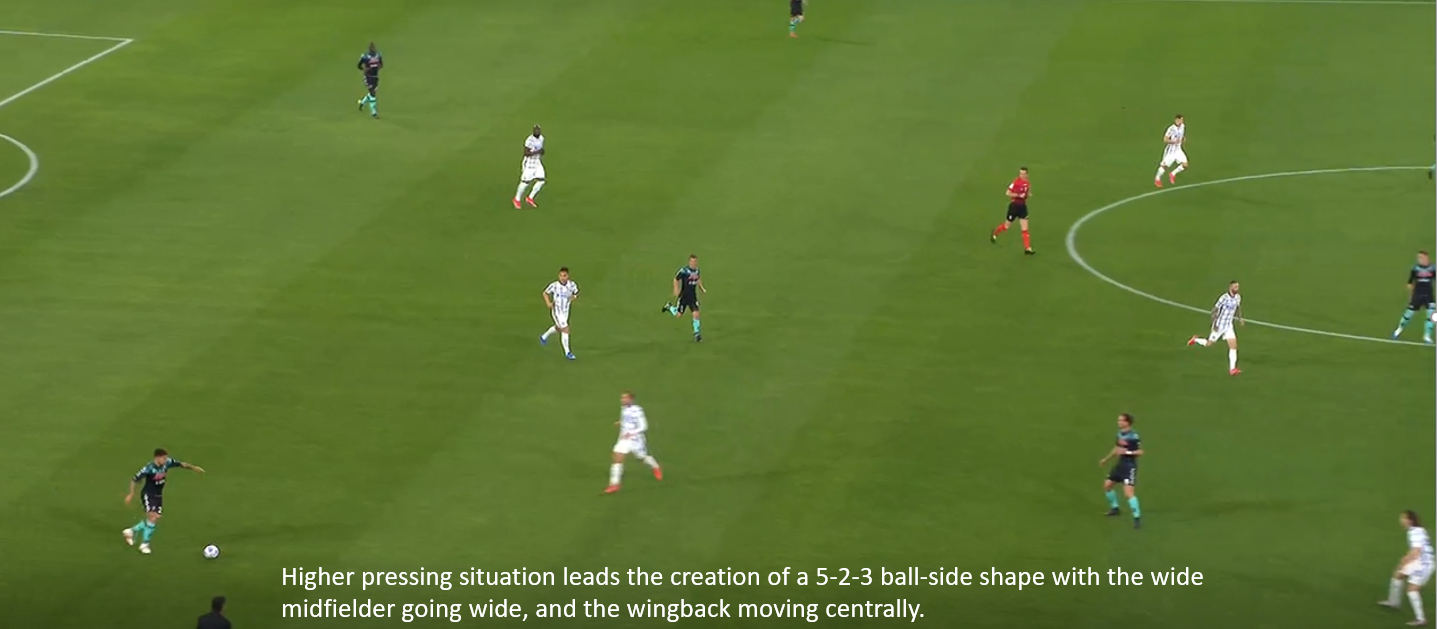
Pressing seems to be dictated to a greater extent by vertical positioning rather than horizontal positioning with regards to the wide midfielders and wingbacks, meaning the midfielder is more inclined to go wide and create a 5-2-3 shape and allow the wing back to compensate centrally, while the centre back if necessary cover the wide space left in behind from the wingback stepping out.
I think this oddly enough is to prevent confusion generated from the centre back pushing too high, causing a series of compensations defensively with the transition to more of a back 4 shape happening more fluidly with the wing-back stepping out, with the subsequent shuttle moreover being fluid after positions have been re-gained.
Although in more aggressive strategise using a back 5, both ball-sided players occupying high man-oriented roles is fairly common in contrast to Inter implementing zonal limits. Safety and blocking space is prioritised over the turnover again.
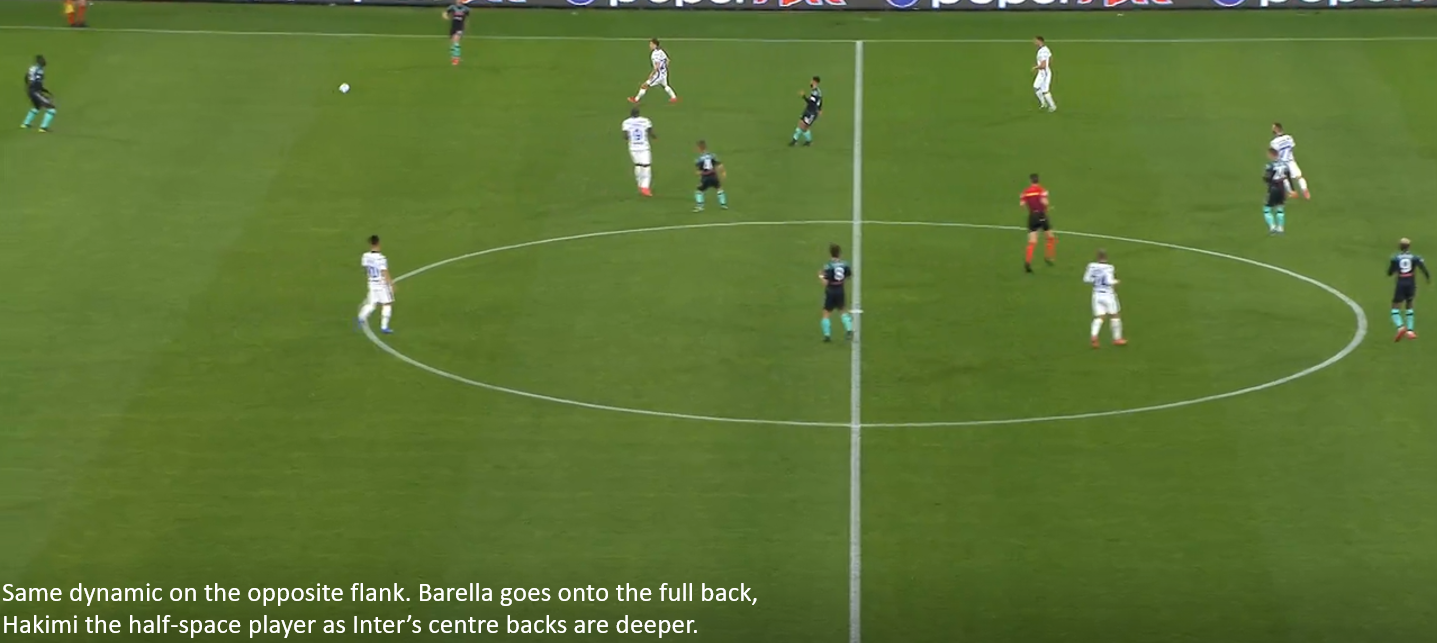
To demonstrate the changing of responsibilities in accordance with the greater compactness allowed by the mid-block where engagements are lower, Bastoni stepped out while Darmian remained wider, pinned by the winger. Critically the centre backs do not step out in high regions, which alters dynamics with regards to covering for spaces in between the lines.
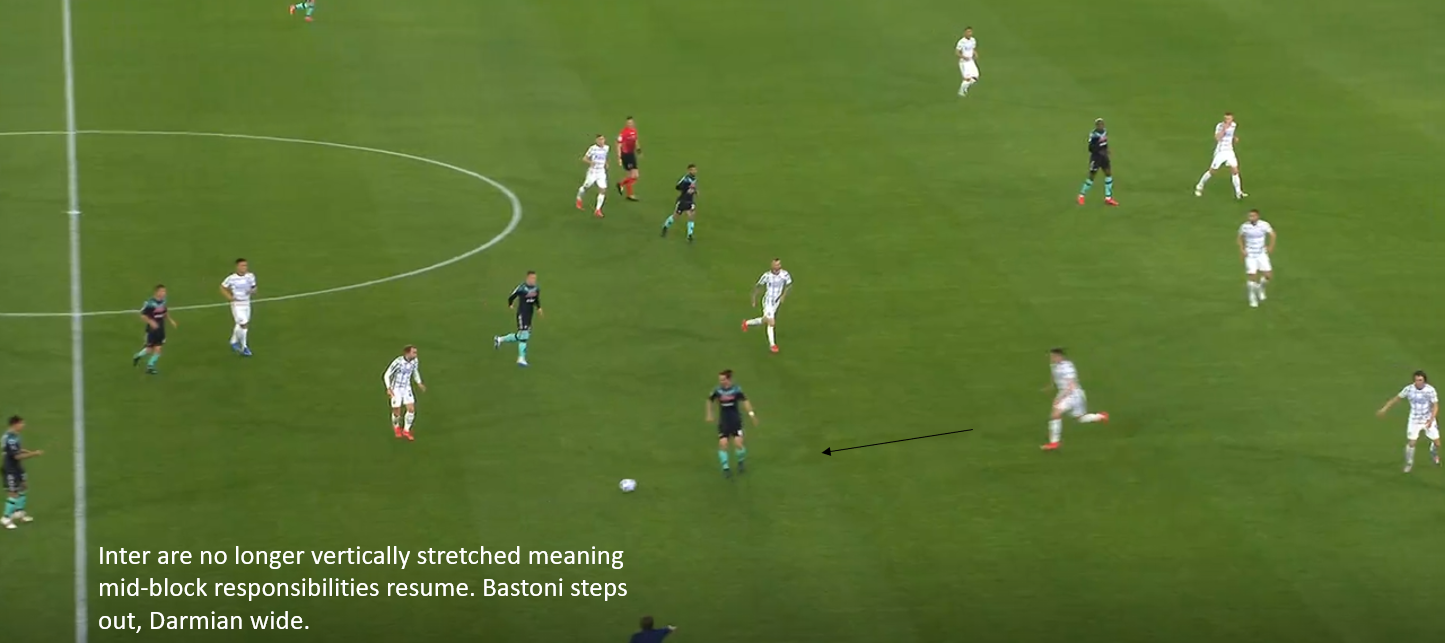
To exemplify issues that occur should the ball-side centre back commit during Inter’s higher engagement, see the confusion between Ashley Young and Matteo Darmian below. There is an element of zonal confusion, as in the mid-block, the dropping half-space player would be the centre backs, hence Darmian’s responsibility.
Darmian needs to remain central as and Young commit to prevent exploitable holes appearing in the last line. The desire here is to show any potential transitions occurring from higher pressing down the flanks where they are considered less dangerous and where the player in possession can be more easily constrained due to having less space available to move into.
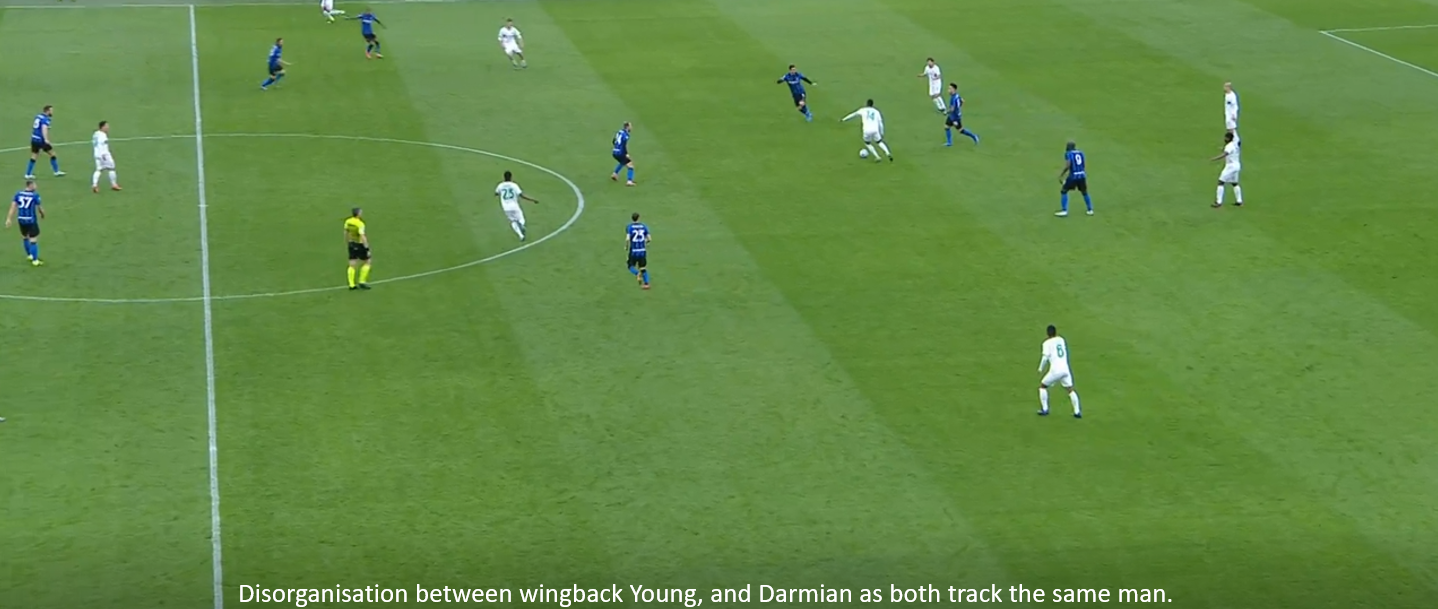
What is occurring here is Inter have engaged higher triggered by a backwards pass and potential isolation opportunities 2v2, where the constraining effect of the by-line is used due to cut-off progressive options due to achievement of numerical parity and tight closing down, forcing play backwards to the goalkeeper and often a direct ball subsequently. This is used when opponents overcommit to attacks, thus allowing the pressure and when a poor back pass is played generating the time needed to reorganise.
When the first line is broken, typically through gradual progression and circulation, many of the principles remain the same, as when overloaded it is the deeper player who is sacrificed with regards to coverage, allowing for circulation and recovery to the initial pressing shape. Their guiding principle seems to be, block of crucial space and more advanced passing options while maintaining good central coverage at the cost of possession control through allowing deep circulation.
Oftentimes, the first line is broken via wide progression where the ball-side becomes more man-oriented looking to compact and isolate, while the centre backs remained predominately man-oriented in between the lines and with regards to tracking potential runs in their zone. The midfield 2 on the central and far-side are more oriented around zonal than player coverage.
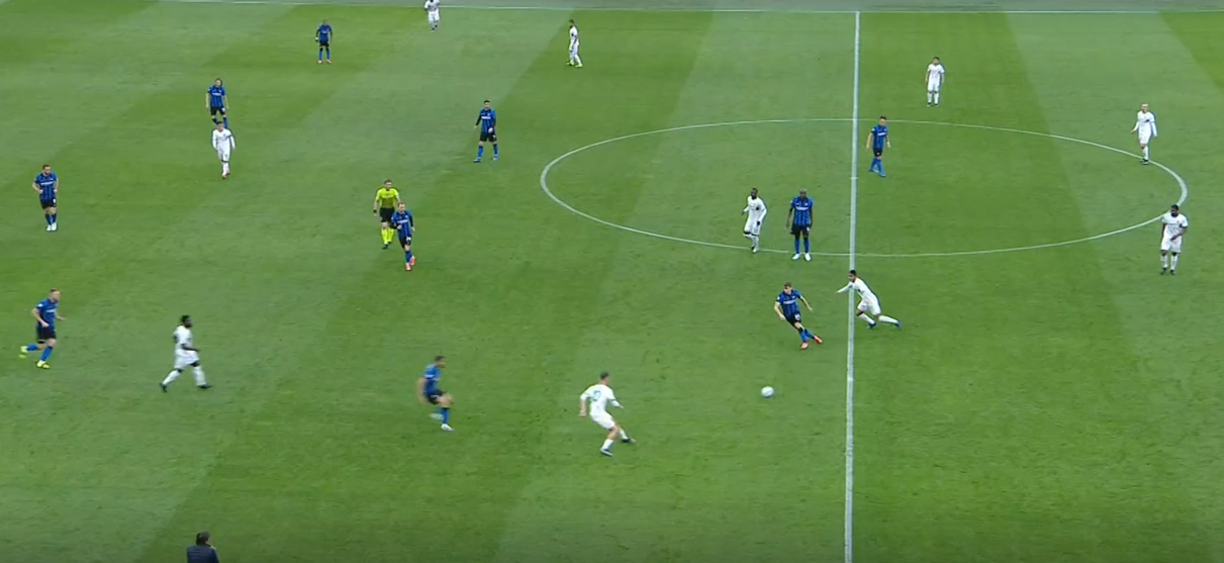
When transforming to the mid-to-low block the centre backs will additionally continue to cover in between the 2nd and 3rd lines but that space will decrease as the side gets more vertically compact as the ball progresses. The wingback remains zonal-man oriented, starting deep and protecting to subsequently pressure when the wide players receive, the space, if seeking to be exploited is covered by the man-oriented centre back. The midfielder remains in position.
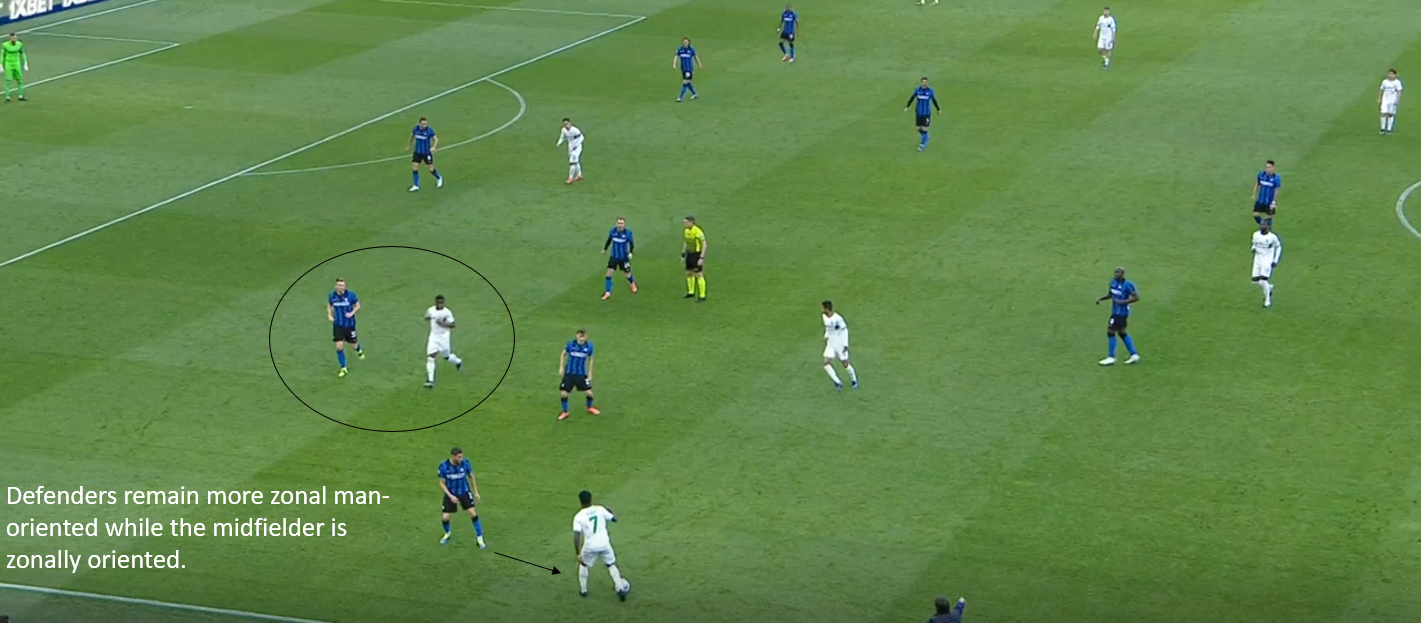
Therefore, the centre backs will ignore dropping threats that support the ball carrier as their orientation is around the responsibility which involves getting tight on a zonal rather than man basis. This reinforces the concept that blocking space is the primary concern of Inter, thus they allow deeper circulation in the high, mid, and mid-to-low phases.
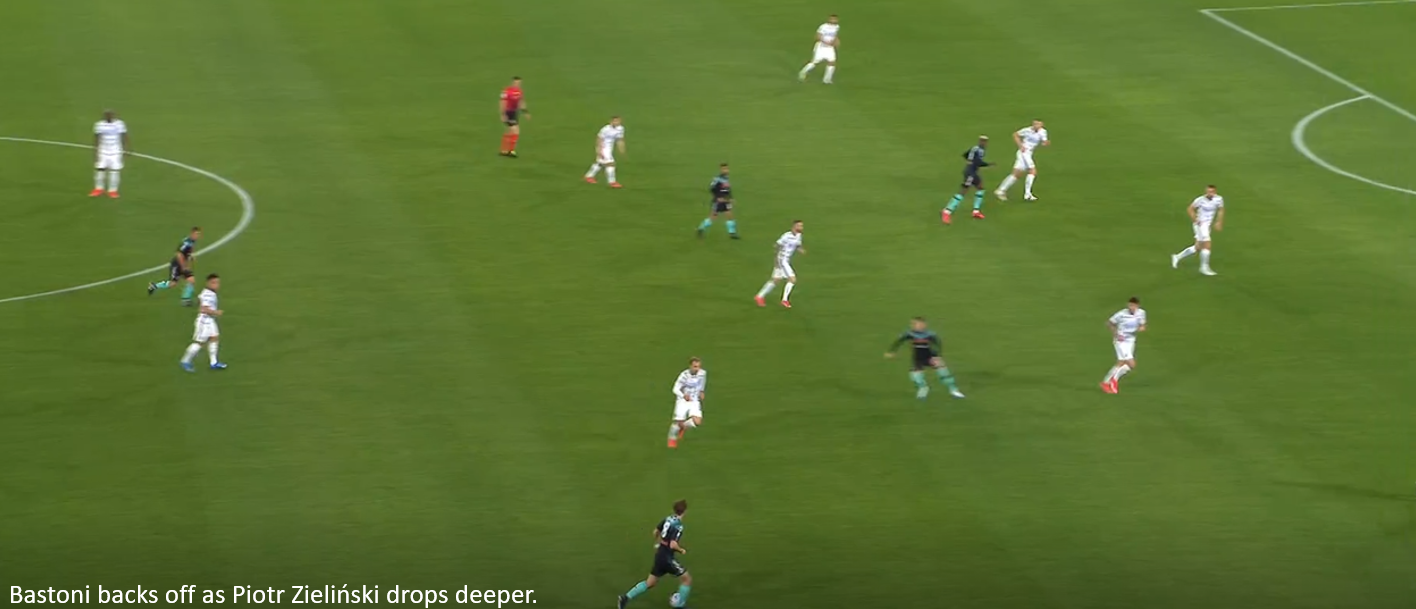
When sitting in the mid-to-low block the ball-side midfielder is no longer responsible for pressing the deep half-space occupier, but rather intent on maintaining the compact 5-3 shape. There is a noticeable reticence to engage but rather shield and attempt to block advantageous passing options (generally those progressive and central), even from midfielders as indefatigable as Barella and Arturo Vidal. The ball-side wing back remains responsible for pressing the opponent’s primary width holder when they enter deeper into Inter’s half.
However, this pressing is done with less intensity and therefore is more considered. Marcelo Brozović role as the free pressing man becomes increasingly important with regards to generating turnovers as he is given the discretion to be more ball-oriented when the opponent attempt to infiltrate centrally. The far side midfielder can also look to compress, creating a convergence trap in between the lines after attempted central progression.
The centre backs generally track runs in behind made into the channels by the men, looking to constrain them out wide. This is particularly common against teams that play two forwards as width remains maintained by a high wing back, meaning the Inter wing back cannot track without the opponent having a passing option forcing the centre back out wide to attempt to limit effective space.
These runs could potentially upset zonal coverage, especially if centre, centre back Stefan de Vrij; however, the theory behind the tracking is that the opposition if committing to a ball-side overload will firstly struggle to make it out of the corner because of the compacting effect of tight tracking, and secondly will have fewer infiltrators following the overload.
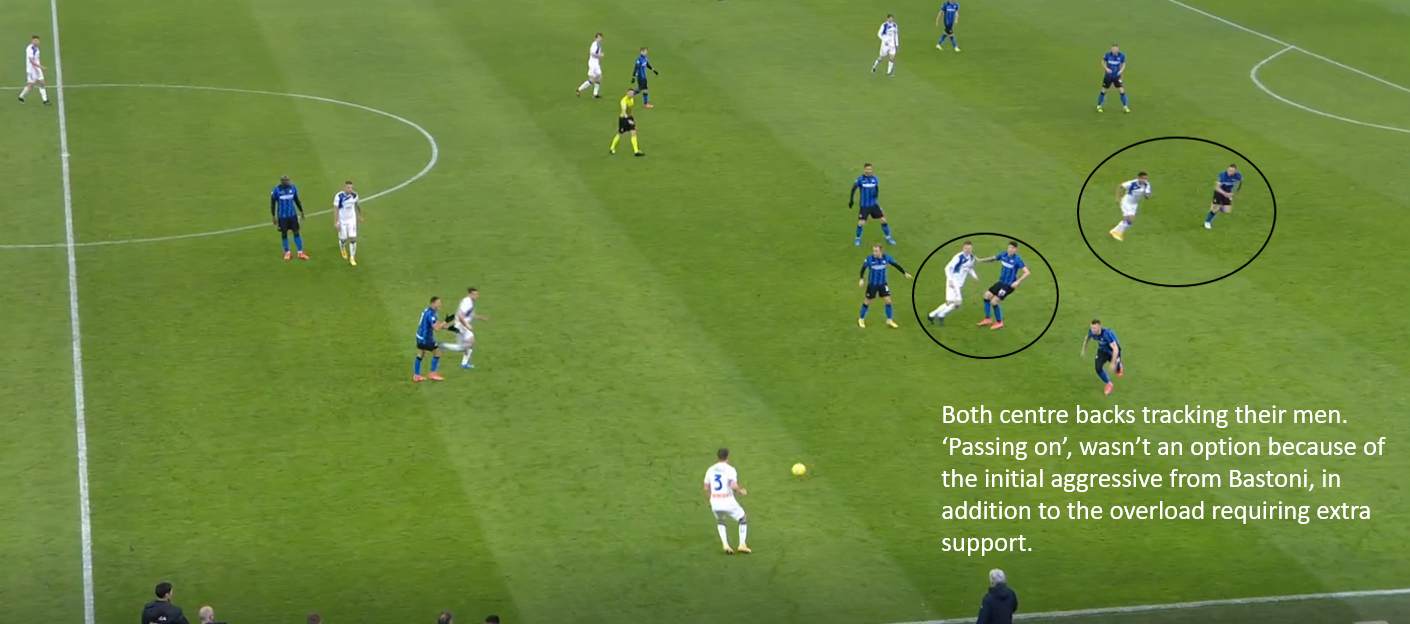
Atalanta exemplify these principles because of their wide overloads (more information here: How Atalanta Use Their Center Backs in Possession – Breaking The Lines) as this forced more ball-side commitment due to the opponent remaining a crucial reference point despite having a more zonal midfield in the mid-to-low block phase. To respond, the wide midfielder (Barella in this example) would jockey his man out-wide gradually allowing the shuttling midfield to support.
The potential for a backwards pass necessitated Inter maintained good horizontal coverage because their lack of vertical coverage created an easy switching connection. Therefore, to maintain midfield coverage while attaining ball-sided compactness, Lautaro Martínez drops deeper creating a 5-4-1 shape. This allows Brozović to shuttle over to maintain compactness to respond to the wide overload, whilst Vidal can come over to support as Lautaro is now covering his defensive zone, meaning in these instances, Inter move into a deeper block.
As a result, this sacrifices vertical coverage which is already lacking when considering the easier progression options due to lack of potential midfield coverage to reinforce said midfield coverage which generates greater compactness while crucial space (active, deep, two thirds) are protected. A chain of covering is therefore triggered by Barella’s movement out wide, with this facilitated compactness increasing the chance of a turnover being generated, particularly if the opponent commits to wide interplay.
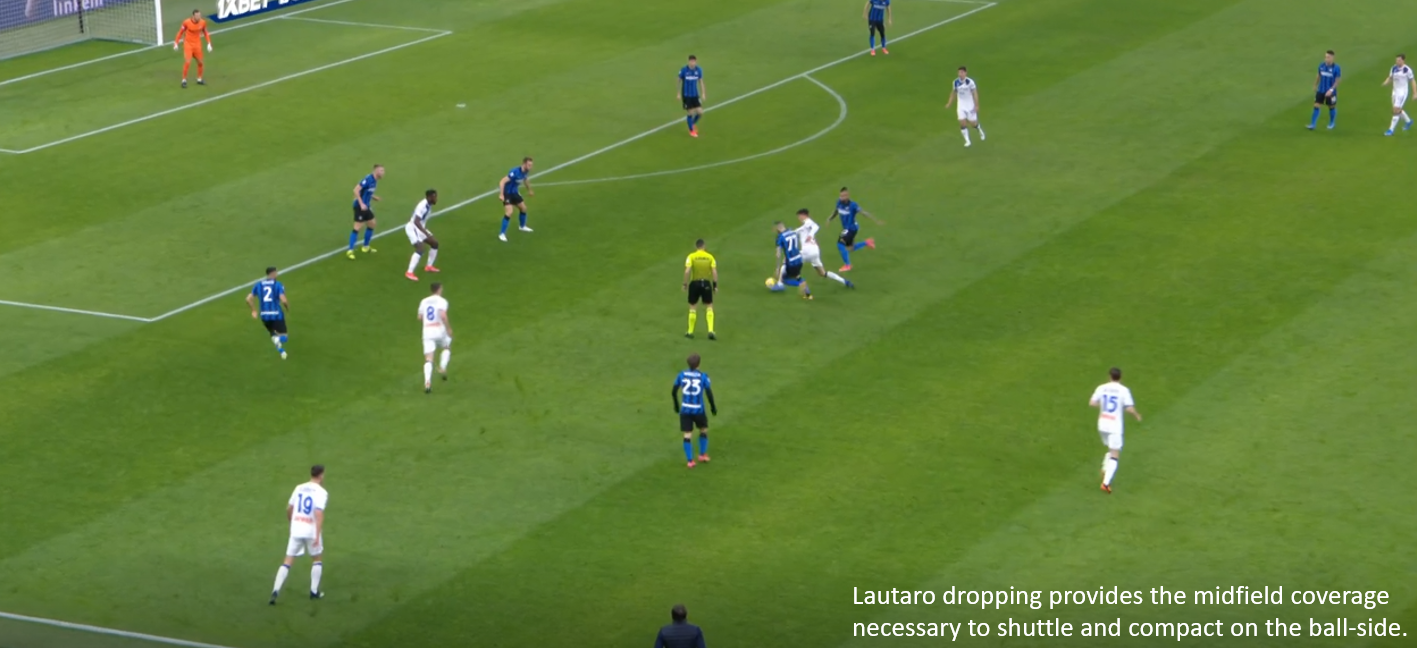
Inter have been exposed most this season when playing this system when the preferred back three of Škriniar, de Vrij and Bastoni has not played together. This is largely due to inadequate back-up featuring converted wingbacks (Danilo D’Ambrosio, Darmian, Kolarov) and Andrea Ranocchia, who despite his physical frame often struggles with the mobility required for duels.
The system is therefore weak when the centre backs, who play a crucial role in preventing infiltration in between the lines, which simultaneously exposes the last line should the opponent win the duel are unable to consistently win these duels which make the 5-3-2 mid-block in particular effective, serving to constrain the opponent. Notwithstanding the role of covering on transitions after periods of pressure or if higher pressing efforts, not seen frequently, fail.
Potential concerns could arise over being overwhelmed by a technically proficient opponent where they are acquiescence and eventually succumb to sustained pressure. Possible worries could occur where they go behind early, something that has seldom happened since the change to the 5-3-2 and struggle to gain control of the game against an opponent happy with the present game-state. However, I do not think these issues are particularly disturbing.
In the first example, arguments could very plausibly be made that space restriction rather than dual involvement is the better approach against a side that can be considered to have the qualitative superiority (very few teams in Europe) because they are both more likely to produce and punish errors and therefore being cautious and ensuring there are players in reserve makes sense. In the second, no team is invulnerable against the vicissitudes of variance; however, the lack of frequency that this has occurred those far serves as a good indicator of the system’s efficacy in preventing it, and moreover, potential system changes in response to game-state can still occur.
Overall, Inter have proven capable of being able to play a more passive, risk averse off the ball style which has served them magnificently defensively while continuing to pick up wins as they stormed triumphantly towards the Scudetto. This has been achieved in combination with their adroit possession play which can generate transitional moments quickly from periods of consolidated possession. (read here: Destroying Man-orientation: Antonio Conte Style – Breaking The Lines and here: Tactical Analysis: Inter’s Wide Overloads – Breaking The Lines)
Inter’s game is built around quick transitions and automatised deep play, hence, using possession as their primary defensive tool would be to neuter their offensive potential. This has allowed them to cede possession control and prioritise blocking space and maintaining compactness off the ball. Antonio Conte successfully identified their defensive weaknesses and found a successful solution which was paramount in ending the Juventus hegemony he started.
By: @mezzala8
Featured Image: @GabFoligno / Marco Canoniero / LightRocket
